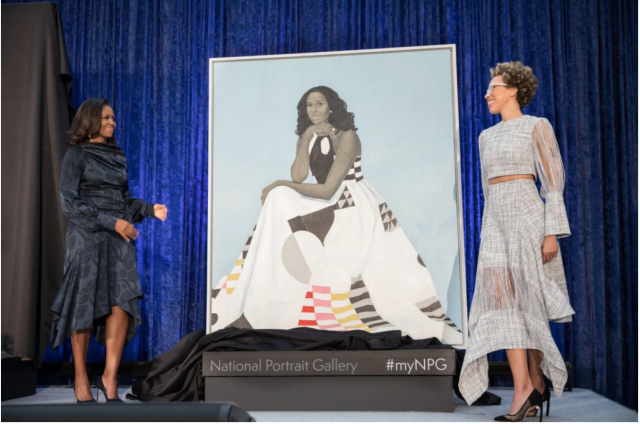The Washington Post
In the past two decades, it has become a rite of passage for soon-to-be-former presidents and first ladies to have their portraits commissioned by the National Portrait Gallery in Washington. Given the glamour of Barack and Michelle Obama and the historic nature of their tenure, gallery officials anticipated a healthy interest in their portraits. Little did they know. The two weeks after the paintings’ public unveiling in February 2018 saw more than 4,100 articles about them published in the domestic and international press. Annual attendance at the museum almost doubled over the next year.
With copious photos, the book “The Obama Portraits” details the creation of the paintings while delving into the significance of their unprecedented popularity.
The choice of artists, both African American, was leaked while the portraits were being executed. Kehinde Wiley, known for his large-scale depictions of African American men in poses and trappings inspired by famous paintings from art history, was painting the president. Amy Sherald had been commissioned to paint the first lady. Sherald had received attention for paintings of African Americans that included many she had met on the streets of her native Baltimore.
Any portrait painter can expect to enter into a struggle with the sitter, as the artist’s vision is unlikely to match exactly the sitter’s self-image. Wiley initially intended to pose the president in a royal manner. In Obama’s comments at the unveiling ceremony — reprinted in the book in full — he explained that the artist’s plan was to “elevate me and put me in these settings with partridges and scepters and thrones and shift robes and mounting me on horses. And I had to explain that I’ve got enough political problems without you making me look like Napoleon. We’ve gotta bring it down just a touch.”

Michelle Obama and Amy Sherald stand alongside the newly unveiled portrait of the former first lady at a ceremony on Feb. 12, 2018. (Pete Souza)
Sherald chose to paint the first lady in a dress designed by Michelle Smith. The choice was a nod both to art history and African American heritage. The geometric designs, Sherald said, call to mind the paintings of Piet Mondrian and the patchwork creations of the now-famous quiltmakers of Gee’s Bend, Ala. Sherald aroused comment with the gray tones of the first lady’s skin in the portrait. She explained that the skin tones were reminiscent of and paid homage to the humble black-and-white photographs of African American women a century ago, women who were not the subjects of large-scale painted portraits.
In an essay in the book, the Portrait Gallery’s director, Kim Sajet, writes that large crowds still make the trip specifically to see the Obama portraits.
—
Related:
The wildly popular Obama portraits are going on a year-long tour to museums across the country